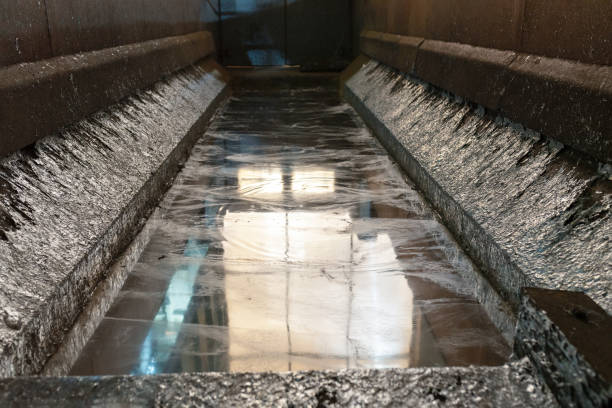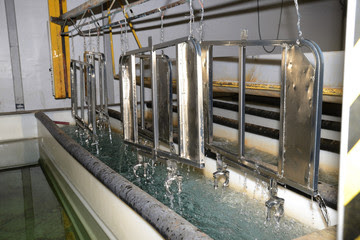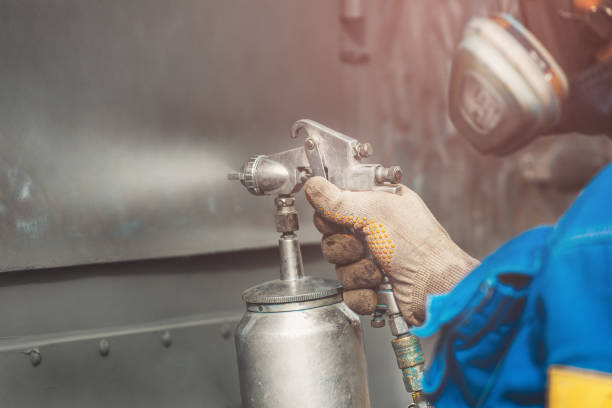The laws of aerodynamics apply to airplanes. It is the study of forces that affect moving objects in the air and explains how air moves around them to produce the force of lift that enables planes to overcome the counterforce of gravity and drag, forces of resistance that act against the force of lift.
The forces involved in aerodynamics can be influenced by numerous factors. In the field of aviation, researchers are constantly trying to develop more aerodynamic, efficient aircraft. Investigating and improving how aircraft materials and their properties can impact air resistance is one area of research that has become a major focus of projects attempting to improve aircraft aerodynamic performance.
Surface coatings can be used to impact the aerodynamic properties of aerospace materials. In this article, we will discuss surface coatings, how they reduce drag, the importance of industrial coatings, and how to choose surface coating products for your projects. Feel free to reach out to us here if you have inquiries concerning your metal coating project.
How Drag Imparts Aerodynamics
Drag in aerodynamics refers to forces that prevent an object from moving relative to another through the air. In an aircraft, thrust defeats drag. Using fuel, aircraft engines produce thrust. Reduced drag will result in less thrust being needed to overcome it, which will result in less fuel being burned.
Aircraft manufacturers spend a lot of time and money during the design phase trying to reduce the drag profile and enhance the overall performance of their products. During the design process, a variety of factors are taken into account, including component weights, aerodynamic shapes, engine efficiency, wing span, winglets, and a host of others, like the addition of suitable fairings or seals and reducing the size and number of exposed components.
Many decisions made during the design phase have corresponding drag components that are unaffected by the subsequent coating of the surface. But skin friction also contributes to drag.
The disruption of airflow across aircraft surfaces results in drag from skin friction. Surface roughness from paint or surface flaws, the adhesion of dirt or dead insects to aircraft surfaces, or the presence of contaminating fluids from leaks, spills, or deicing will all increase skin friction. Surface coatings may be able to reduce drag in these situations.
Can Coatings Reduce Drag?
It is true that a surface may occasionally need to be made non-slip or non-stick. For instance, contaminants adhering to the surfaces of aeronautical materials may be the cause of drag. Industrial coatings can be used to give these materials a non-stick property, which will lower drag and improve the material’s overall aerodynamic performance. Therefore the simple answer to this question is that coating may reduce the tendency for drag to occur in a material.
What Is Surface Coating?
It can be defined as a mixture of pigments, binders, solvents, and additives. The surface on which it is applied receives decoration and protection from the surface coating. The surface coating completely covers the surface and acts as an inhibitor of corrosion. The following factor affects whether a coating is successful or unsuccessful:
- Substrate condition
- Surface condition and method of application
- Environmental condition at which it is applied and expected to withstand during service
- And last but not least, the quality of paint used
What Is The Drag-Reducing Surface Coating Process?
A metallic coating can be applied as a surface treatment in a variety of ways to improve a material’s mechanical, electrochemical, and thermal performance. The method is largely determined by the material application and the depth of coating or surface treatment that is desired. Although there are many technologically sophisticated methods for coating metallic and non-metallic surfaces, understanding a few fundamental principles and techniques can help one gain a deeper understanding of surface coating procedures.
How Does The Industrial Coating Process Work?
The two most frequently specified families of surface coating techniques can be divided into two groups: plating processes and vapor deposition processes, at the risk of oversimplifying. However, there are additional sub-distinctions within these two categories; typical examples of each procedure are given and profiled below.
Plating Processes
Hot- Dipping
This process is typically a continuous or batch immersion process where the base alloy (typically steel) is fully submerged in a molten zinc bath. The hot-dipped zinc coatings form a coherent coating due to metallurgical bonds that form between the base metal and the zinc at the high bonding temperature.
This technique is widely used across applications that demand a high level of atmospheric protection from corrosion of the base steel. Although most commonly used on steel alloys, variations in the galvanic hot dipping process is also feasible for coating other metals, such as aluminum.
Electroplating
In this electrochemical procedure, a cathodic polarization reaction deposits metallic ions on the surface of the bulk material. The metal chrome is frequently electroplated onto materials to increase wear resistance or even just to add a decorative finish, as is the case with many “chrome-plated” automotive parts. Thicker electrodeposited chromium coatings provide excellent abrasion and wear resistance.
Cladding
The literal definition of this process is the mechanical joining of two different metals, such as by rolling or extruding the materials together at high temperatures to produce a pressure-welded joint of two different metallic alloys.
Because the “composite” material retains all the advantageous qualities of both required materials, this method is advantageous.
Vapor Deposition Processes
Physical Vapor Deposition (PVD)
When a physical process involving the movement of particles across actual material phase boundaries is used, the material surface coating is applied by the condensation of the vaporized alloy coating onto the material surface (from gas to solid). Simply put, the surface coating alloy is vaporized first and then sprayed onto the base metal’s surface (typically within a vacuum). PVD comes in a variety of forms and subsets, but this is its fundamental operating principle. Thin titanium nitride (TiN) coatings are frequently applied using PVD to harden metal cutting tools and significantly improve wear resistance.
Chemical Vapor Deposition (CVD)
In contrast to PVD, a gas mixture and the bulk surface of the material actually interact chemically during CVD, leading to the chemical decomposition of some of the individual gas constituents and the formation of a solid coating on the surface of the base material. CVD is used in a variety of industrial applications, such as the deposition of refractory materials on turbine blades to significantly improve the blades’ resistance to wear and thermal shock. Refractory materials are non-metallic materials that can withstand extremely high temperatures.
Why Use Industrial Coating?
Industrial coatings are one area that many managers tend to overlook. They contribute to safety in a variety of ways behind the scenes, but they don’t seem to matter all that much until they start to malfunction and need to be replaced. Industrial coatings are essentially specialized paints that are applied to steel or concrete to protect it from corrosion.
No business can afford to put off coating a new piece of equipment or performing routine maintenance on existing industrial coatings. Here are a few causes for this:
They Provide Protection
There is frequently a pressing need to protect the object being coated. There are numerous other reasons why things need to be protected. For instance, a floor underneath several large, heavy pieces of machinery needs to be protected if it’s going to last longer than a year or so.
Heavy wear is unavoidable in any industrial setting, so you can protect different surfaces and help them maintain their sheen, hardness, or any other property you want them to retain for a longer period of time by applying an industrial coating.
They Can Reduce Drag
A surface may occasionally need to be made non-slip or non-stick. For instance, drag may be caused by impurities sticking to the surfaces of aviation materials. These materials can be given a non-stick quality through industrial coating, which will reduce drag and enhance the material’s overall aerodynamic performance.
For other machines to process materials quickly and well, a non-stick surface may be required inside. The best way to keep a variety of surfaces safe is with industrial coatings.
They Prevent Corrosion
Another problem that frequently arises in industrial applications is corrosion-causing debris, such as rust. The materials that can actually be used to build machinery are frequently the ones that corrode over time. These machines can occasionally corrode as a result of the materials that pass through them.
The only remedy is the application of an industrial coating, which can be designed to offer the ideal connection between the machine and the material it is processing. It can resist not only the material being processed but it can also stop normal corrosion that might happen due to the material the machine is made of.
They Keep Surfaces Clean
You are not constrained in the kind of surface you can have with industrial coatings. Frequently, the primary component won’t be made of a material whose surface can maintain cleanliness while being used in certain industrial applications.
However, you will benefit from cleaner surfaces because the materials will flow straight through the machine if you engineer a coating that will specifically resist whatever you are processing.
Choosing The Right Metal Coating Products For Your Company
There are a number of different factors to take into account when selecting the best coating product for your unique needs.
Consider your objectives for using metal coatings first. How will your customers use the finished product, and in what kind of environment will the paint be used? Consider your requirements for the paint’s durability, the standards you must meet for your painting system, and the sustainability philosophy of your business. Take into account your current procedures, your tools, the kinds of metal surfaces you work with, and whether you paint or assemble first.
Consider your spending plan while keeping in mind that some products have a higher initial cost but are more cost-effective over the long run.
Finally, speak to metal coating experts about your project; they are always going to have helpful information to give to you. You can reach out to us here for all your surface coating inquiries.
Final Thoughts
By increasing lift and decreasing drag, better aerodynamics could reduce aircraft fuel consumption. This might eventually cause the aviation industry to use significantly less fuel, which would lower the emissions generated by this industry. Surface coating is a crucial technique in the aerospace and aviation industries as a result.
Before starting any surface coating project, it is strongly recommended that you consult with reputable surface coating experts. For any questions about surface coatings, contact us here, and we’d be happy to help.
FAQs
How can I ensure the health and safety of those working with industrial paints and coatings?
In an effort to increase user health and safety and lower the risk of explosions, many businesses opt to use water-borne products. Utilizing water-borne coatings reduces the user’s risk of irritation and other negative side effects. However, users must always take proper precautions to protect themselves, regardless of the metal coatings they work with.
In the event of inadequate ventilation, users should put on protective gloves, clothing, and eye protection in addition to respiratory protection. Both water-borne and solvent-borne product applications involve risks when fumes are inhaled. However, since water evaporates during the drying process for products that are water-borne rather than organic solvents, inhalation is not as dangerous.
What is the purpose of surface preparation?
In order for a material to be coated, adhered to another material, or be used in other surface-related applications, it must first undergo surface preparation. The effectiveness of a new coating, the success of adhesion, or other aspects of a process can all be severely hampered by a dirty, oily, flaky, or otherwise compromised surface.
Surface preparation helps to prevent future issues, such as corrosion and mechanical damage, while also ensuring the best mechanical bonding, adhesion, or weld quality.
Is surface preparation important in adhesive bonding?
Surface cleaning provides the clean, dry surface that is necessary for adhesive bonding, resulting in high bond strengths and durability. Surface preparation techniques range from simple brushing to more thorough abrasive cleaning, depending on the substrate material. The smallest activities can have a big impact on a bond’s consistency and effectiveness, even when little preparation is needed.
Why is surface preparation important before coating?
The success of a coating system is thought to depend primarily on surface preparation. The coating’s ability to stick to the substrate material has an impact on how well it performs. In addition to eliminating unwanted contaminants like mill scale or grease, surface preparation also introduces a suitable profile for the coating.
In the majority of cases, grit blasting is carried out manually but is increasingly being mechanized to ensure process control and reproducibility to ensure performance in service.
How does surface finish impact coatings?
The performance of coatings will also be impacted by the metal surface finish. An application of a more uniform layer of coating will be possible with a finer surface finish. Generally speaking, you ought to request a slightly superior surface finish than usual. As a result, the coating’s lubricity, toughness, and adhesion will all be maximized. Applications that require friction, like thread rolling dies, would be an exception to this rule. In these situations, seek advice from a valence coating specialist on methods for boosting friction while enhancing toughness.



